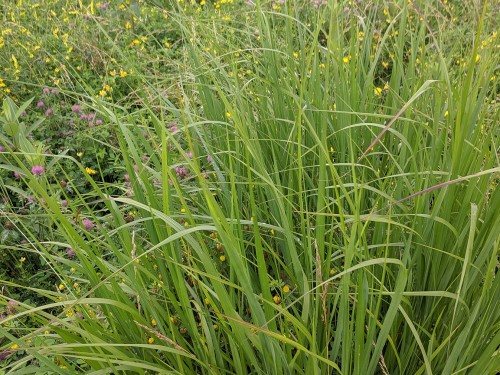Prairie grasses have extensive root systems that help them survive in flood and drought conditions but take longer to establish.
September 9, 2019

Many farmers in the Midwest might be trying to grow and feed their animals different grasses this year, since supplies for hay and traditional forage grasses are exceptionally low.
Ohio’s hay supply is the lowest since the 2012 drought and the fourth lowest in 70 years, according to an announcement from The Ohio State University College of Food, Agricultural & Environmental Sciences. The persistently wet spring this year may have hindered the growth and cutting of hay and other forage grasses.
“Nobody can control the weather, but we can somewhat control what we’re growing on the farm,” Ohio State University Extension educator Christine Gelley said. “If we can become more flexible in terms of what we grow and how we move our animals around, that can increase our options for feeding them.”
Typically, Ohio farmers grow cool-season grasses for their cows, sheep and other livestock, including orchardgrass and Kentucky bluegrass, Gelley said. The problem is that those grasses can’t always withstand an abundance of rain, which has become increasingly common in recent years.
Unlike cool-season grasses, prairie grasses have extensive root systems that help them survive in flooded conditions and even drought, Gelley said. The downside is that prairie grasses can take three years to get established.
“It’s not something we could plant this fall and expect to sustain our animals next spring, but once they’re established, they can last for decades,” Gelley said.
Reed canarygrass, a cool-season grass not commonly used for grazing, can be a good forage source for animals and is very tolerant of chronically wet soils, Gelley said. Anyone who plants reed canarygrass should be aware that it’s an invasive species and can easily take over a field unless animals graze it often, she said.
Tall fescue, the most common grass in Ohio, also can withstand soggy soil, but certain varieties of the grass can limit weight gain in livestock that eat it. Tall fescue contains a fungus that makes the plant more resistant to drought but also can limit weight gain. However, some varieties, while still containing the fungus, do not have that effect on animals’ weight, Gelley said.
With many of the alternative grasses, there are trade-offs to consider before planting them.
Gelley explained, “Which would you rather have during extreme weather events: nothing for your animals to eat, or something with issues that we know we can work around?”
Source: The Ohio State University, which is solely responsible for the information provided and is wholly owned by the source. Informa Business Media and all its subsidiaries are not responsible for any of the content contained in this information asset.
You May Also Like

.png?width=300&auto=webp&quality=80&disable=upscale)

